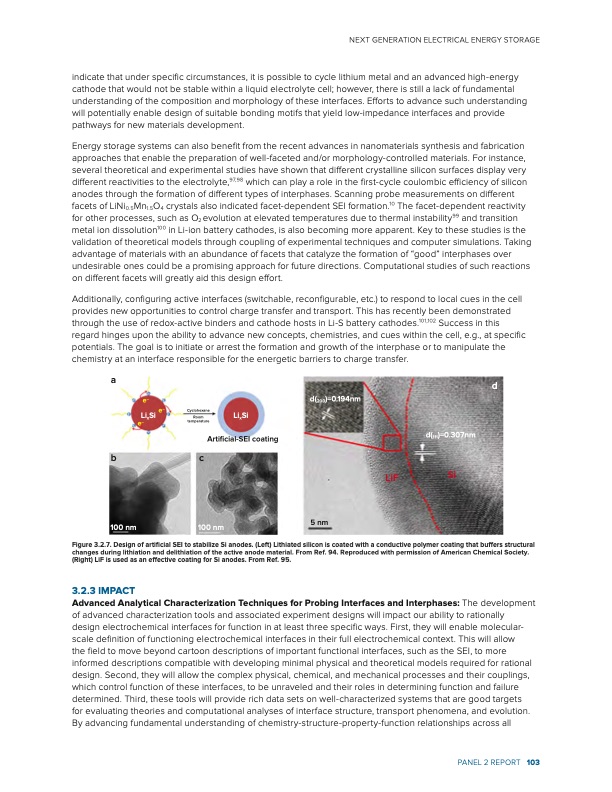
PDF Publication Title:
Text from PDF Page: 109
indicate that under specific circumstances, it is possible to cycle lithium metal and an advanced high-energy cathode that would not be stable within a liquid electrolyte cell; however, there is still a lack of fundamental understanding of the composition and morphology of these interfaces. Efforts to advance such understanding will potentially enable design of suitable bonding motifs that yield low-impedance interfaces and provide pathways for new materials development. Energy storage systems can also benefit from the recent advances in nanomaterials synthesis and fabrication approaches that enable the preparation of well-faceted and/or morphology-controlled materials. For instance, several theoretical and experimental studies have shown that different crystalline silicon surfaces display very different reactivities to the electrolyte,97,98 which can play a role in the first-cycle coulombic efficiency of silicon anodes through the formation of different types of interphases. Scanning probe measurements on different facets of LiNi0.5Mn1.5O4 crystals also indicated facet-dependent SEI formation.10 The facet-dependent reactivity for other processes, such as O2 evolution at elevated temperatures due to thermal instability99 and transition metal ion dissolution100 in Li-ion battery cathodes, is also becoming more apparent. Key to these studies is the validation of theoretical models through coupling of experimental techniques and computer simulations. Taking advantage of materials with an abundance of facets that catalyze the formation of “good” interphases over undesirable ones could be a promising approach for future directions. Computational studies of such reactions on different facets will greatly aid this design effort. Additionally, configuring active interfaces (switchable, reconfigurable, etc.) to respond to local cues in the cell provides new opportunities to control charge transfer and transport. This has recently been demonstrated through the use of redox-active binders and cathode hosts in Li-S battery cathodes.101,102 Success in this regard hinges upon the ability to advance new concepts, chemistries, and cues within the cell, e.g., at specific potentials. The goal is to initiate or arrest the formation and growth of the interphase or to manipulate the chemistry at an interface responsible for the energetic barriers to charge transfer. a d d(111)=0.307nm Si bc 100 nm 100 nm Artificial-SEI coating Figure 3.2.7. Design of artificial SEI to stabilize Si anodes. (Left) Lithiated silicon is coated with a conductive polymer coating that buffers structural changes during lithiation and delithiation of the active anode material. From Ref. 94. Reproduced with permission of American Chemical Society. (Right) LiF is used as an effective coating for Si anodes. From Ref. 95. 3.2.3 IMPACT Advanced Analytical Characterization Techniques for Probing Interfaces and Interphases: The development of advanced characterization tools and associated experiment designs will impact our ability to rationally design electrochemical interfaces for function in at least three specific ways. First, they will enable molecular- scale definition of functioning electrochemical interfaces in their full electrochemical context. This will allow the field to move beyond cartoon descriptions of important functional interfaces, such as the SEI, to more informed descriptions compatible with developing minimal physical and theoretical models required for rational design. Second, they will allow the complex physical, chemical, and mechanical processes and their couplings, which control function of these interfaces, to be unraveled and their roles in determining function and failure determined. Third, these tools will provide rich data sets on well-characterized systems that are good targets for evaluating theories and computational analyses of interface structure, transport phenomena, and evolution. By advancing fundamental understanding of chemistry-structure-property-function relationships across all NEXT GENERATION ELECTRICAL ENERGY STORAGE e– LixSi e– e– Cyclohexane Room temperature LixSi d(200)=0.194nm 5 nm LiF PANEL 2 REPORT 103PDF Image | Next Generation Electrical Energy Storage

PDF Search Title:
Next Generation Electrical Energy StorageOriginal File Name Searched:
BRN-NGEES_rpt-low-res.pdfDIY PDF Search: Google It | Yahoo | Bing
Sulfur Deposition on Carbon Nanofibers using Supercritical CO2 Sulfur Deposition on Carbon Nanofibers using Supercritical CO2. Gamma sulfur also known as mother of pearl sulfur and nacreous sulfur... More Info
CO2 Organic Rankine Cycle Experimenter Platform The supercritical CO2 phase change system is both a heat pump and organic rankine cycle which can be used for those purposes and as a supercritical extractor for advanced subcritical and supercritical extraction technology. Uses include producing nanoparticles, precious metal CO2 extraction, lithium battery recycling, and other applications... More Info
| CONTACT TEL: 608-238-6001 Email: greg@infinityturbine.com | RSS | AMP |